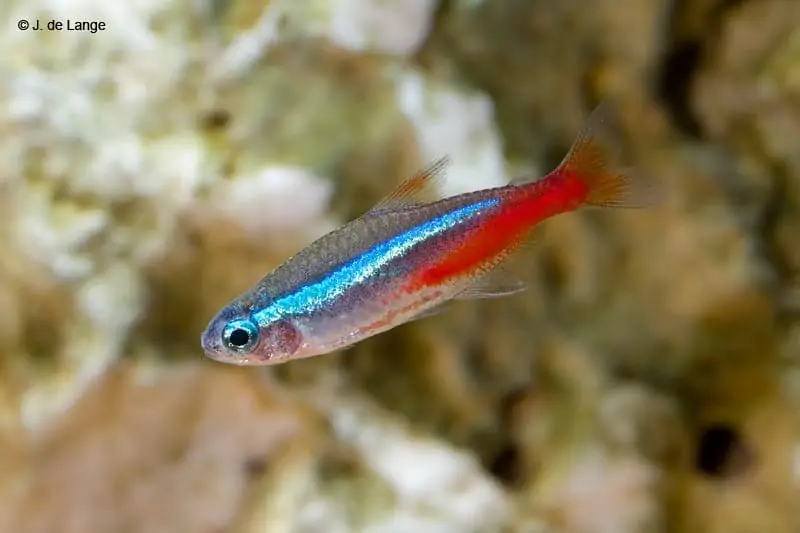Paracheirodon innesi – Neon Tetra
The Neon Tetra was first described by Myers in 1936 The name is divided into several pieces and is derived from the Greek. Para means “almost or wrong”, cheir means “hand-shaped” and odous = “tooth”. This species is named after the American ichthyologist William Thornton Innes.
This known fish has only one synonym: Hyphessobrycon innesi.
Description
Together with the Cardinal Tetra, the Neon Tetra belongs to the most kept fish in aquaria. With the discovery of the cardinal tetra, the popularity of this beautiful fish has diminished.
The first thing you notice when you see Paracheirodon innesi are their colors. From the tip of their nose, a fluorescent blue bar runs horizontally to the back. From halfway their body, you can see a clear red bar running into their caudal fin. They can reach a total length of around 5 centimeters.
The biggest difference between the Neon and Cardinal Tetra is that the Neon Tetras red band starts halfway their body, with the Cardinal Tetra having a red band across the entire length of the fish. A second difference is that the Neon Tetra can be bred in captivity, whereas the difficulties for the Cardinal Tetra are so big that it is not commercially interesting to do.
Biotope
The Neon Tetra is found in the blackwater lakes in the upper part of the Amazon (Peru, Brazil). They occur in a wide area that can be separated from hundreds of kilometers. To date, the entire distribution area is still not well mapped.
In these areas, the Neon Tetra inhabits the smaller streams and side branches of the rivers. They mainly occur in water that is darkened from the humus acids of the decomposing plant material such as leaves and roots. In the biotope where you can find the Paracheirodon innesi – Neon Tetra, the soil is usually littered with roots, branches and loose leaves.
The Aquarium
It is a schooling fish that best fits into some larger groups of at least 10 fish but more is even better. A slightly darker soil and good planting makes this small species feel comfortable. Do not forget to provide them some swimming space so you can admire the interesting behaviour of schooling.
Given the maximum size of 4 to 5 centimeters, it is not recommended to keep this species with larger carnivorous cichlids. This also applies to Angelfish, many forget that these are also hunters, the smaller Paracheirodon innesi will become a nice snack.
Like with all other fish, water changes are necessary as they are very prone to clean water. The water should be slightly acidic pH 6.5 – 7 but something above or below will usually not cause any problems.
Diet
Neon Tetra are not a picky eaters, almost all kinds of food are eaten, but the small mouth must be taken into account. They are omnivorous but feeding only flakes will not keep them healthy. So feed them a variety of foods like flakes and small live or frozen foods as this will certainly benefits their health.
The Spawn
Although spawning Neon Tetra’s is easier than spawning the Cardinal Tetra, it is still not easy. The natural waters contain virtually no minerals, and because of humus acids have a pH of around 5 to 6. This is too low for a community aquarium to keep plants and also not stable enough to be healthy for the fish.
If you want to breed the Paracheirodon innesi, the water must be mild and acidic (GH between 2-6), filtering over peat provides the necessary acids. To ensure that the parents do not eat the eggs, the spawn can best be done in a small aquarium with a mesh about 2 cm above the bottom where the parents can not pass through (make sure to secure the sides). On top of the mesh you can put some javamos.
After depositing the eggs they fall to the bottom through the mesh where the parents can’t reach them. Once the parents have finished pairing, you can put them back with the other fish. The eggs hatch after 36 hours and after 5 days they can swim free. Only then you can start feeding! The tiny fry can be fed with infusoria for the first few days. Once they are slightly larger you can feed them with microworms, artemia and other small foods.
The breeding tank can be filtered with a sponge filter. The advantage of such a filter is that on the filter surface small organisms grow of which the newly-emerged young Neon Tetra’s can feed.
Video
Author
John de Lange
Copyright images
John de Lange

















Reviews
There are no reviews yet.